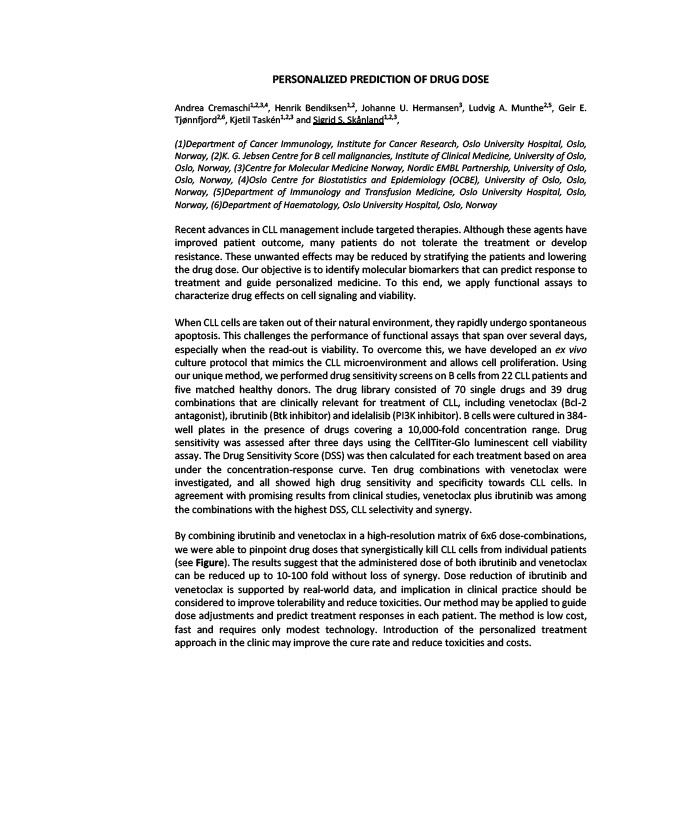
PERSONALIZED PREDICTION OF DRUG DOSE
Andrea Cremaschi1,2,3,4, Henrik Bendiksen1,2, Johanne U. Hermansen3, Ludvig A. Munthe2,5, Geir E.
Tjønnfjord2,6, Kjetil Taskén1,2,3 and Sigrid S. Skånland1,2,3,
(1)Department of Cancer Immunology, Institute for Cancer Research, Oslo University Hospital, Oslo,
Norway, (2)K. G. Jebsen Centre for B cell malignancies, Institute of Clinical Medicine, University of Oslo,
Oslo, Norway, (3)Centre for Molecular Medicine Norway, Nordic EMBL Partnership, University of Oslo,
Oslo, Norway, (4)Oslo Centre for Biostatistics and Epidemiology (OCBE), University of Oslo, Oslo,
Norway, (5)Department of Immunology and Transfusion Medicine, Oslo University Hospital, Oslo,
Norway, (6)Department of Haematology, Oslo University Hospital, Oslo, Norway
Recent advances in CLL management include targeted therapies. Although these agents have
improved patient outcome, many patients do not tolerate the treatment or develop
resistance. These unwanted effects may be reduced by stratifying the patients and lowering
the drug dose. Our objective is to identify molecular biomarkers that can predict response to
treatment and guide personalized medicine. To this end, we apply functional assays to
characterize drug effects on cell signaling and viability.
When CLL cells are taken out of their natural environment, they rapidly undergo spontaneous
apoptosis. This challenges the performance of functional assays that span over several days,
especially when the read-out is viability. To overcome this, we have developed an ex vivo
culture protocol that mimics the CLL microenvironment and allows cell proliferation. Using
our unique method, we performed drug sensitivity screens on B cells from 22 CLL patients and
five matched healthy donors. The drug library consisted of 70 single drugs and 39 drug
combinations that are clinically relevant for treatment of CLL, including venetoclax (Bcl-2
antagonist), ibrutinib (Btk inhibitor) and idelalisib (PI3K inhibitor). B cells were cultured in 384-
well plates in the presence of drugs covering a 10,000-fold concentration range. Drug
sensitivity was assessed after three days using the CellTiter-Glo luminescent cell viability
assay. The Drug Sensitivity Score (DSS) was then calculated for each treatment based on area
under the concentration-response curve. Ten drug combinations with venetoclax were
investigated, and all showed high drug sensitivity and specificity towards CLL cells. In
agreement with promising results from clinical studies, venetoclax plus ibrutinib was among
the combinations with the highest DSS, CLL selectivity and synergy.
By combining ibrutinib and venetoclax in a high-resolution matrix of 6x6 dose-combinations,
we were able to pinpoint drug doses that synergistically kill CLL cells from individual patients
(see Figure). The results suggest that the administered dose of both ibrutinib and venetoclax
can be reduced up to 10-100 fold without loss of synergy. Dose reduction of ibrutinib and
venetoclax is supported by real-world data, and implication in clinical practice should be
considered to improve tolerability and reduce toxicities. Our method may be applied to guide
dose adjustments and predict treatment responses in each patient. The method is low cost,
fast and requires only modest technology. Introduction of the personalized treatment
approach in the clinic may improve the cure rate and reduce toxicities and costs.